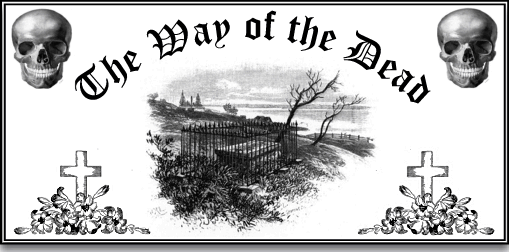
There is a sinister pathway that winds its sombre way across the northern wastes of Dartmoor, it is known as the ‘Way of the Dead’, the ‘Corpse Way‘, or the Lych Way. Its roots are firmly set deep in the days when every person on the moor was expected to attend their church for services and burials. That may not seem any different to the rest of the country in medieval times, except for some of them it involved a trudge of about 12 miles and in bad weather this would increase to roughly 17 miles.
In the 1200’s colonisation of Dartmoor started by the founding of the Ancient Tenements which was mainly along the West and East Dart valleys and their tributaries. These early farmsteads were in effect freeholds and providing the King’s hunting was not ‘hindered’ there was no problem. The map below shows the sites of the tenements.
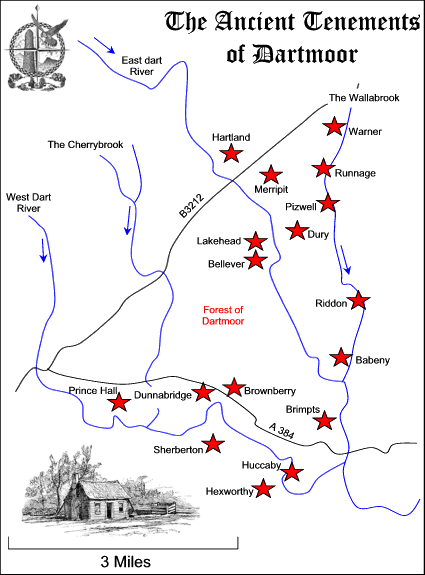
So what have these early farms to do with the Lych Way? Simply that it was the inhabitants from many of these tenements that were expected to travel to Lydford to bury their dead and attend services. Why, because the tenements were within the bounds of the Forest of Dartmoor and therefore were in the parish of Lydford, which was where the parish church was located. In 1260 the tenement dwellers became fed up with this onerous journey and so partitioned the Bishop of Exeter, Walter Bronescombe, for permission to attend the church at Widecombe which was a lot closer. The bishop duly granted their request which one would have thought would have seen the demise of the Lych Way. However, this was not the case as the people were still expected to attend the Forest and Stannary courts that were held at Lydford and this continued until the demise of the courts in the 1800’s. In addition, in the 15th and 16th centuries the new farms that developed in the south of the area were not given dispensation to use Widecombe church so they still had to trudge across the moor. The map below shows the route of the Lych Way:
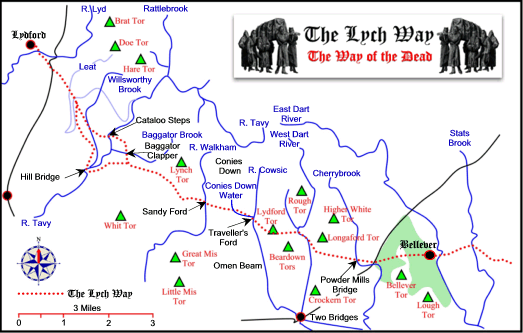
One really atmospheric way of walking the Lych Way is to do it on a summer’s night and as the night slowly draws its mantle of darkness over the moor you can easily imagine the slow creaking noise of an old cart as it trundles the corpse to Lydford church. In parts, especially the section from Conies Down to Sandy Ford the sunken holloway can be discerned with wheel ruts still visible. The aerial photograph below shows the section of the path from Travellers Ford to Sandy Ford and clearly shows the track winding across between the two valleys of the Cowsic and the Spriddle Lake where it went on to Coffin Wood.
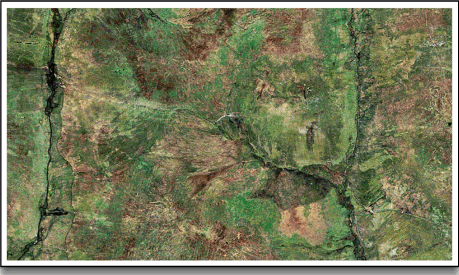
At one time on a large boulder above Traveller’s Ford there was a small brass cross whose purpose was unknown but it may have been a modern memorial to mark the Lych Way path below. As you can imagine there is/was a plethora of letterboxes to be found along the Lych Way, most of them depicting coffins, skeletons and other such morbid subjects, as show in one of my favourites below
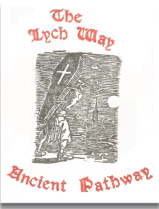
One would have thought that with the nature of the Lych Way there would be scores of tales of ghosts and hauntings but surprisingly enough there is but one tale about ghostly funeral processions and monks.
I have recently received an email from Steve who sent me a YouTube link for a group called ‘Show of Hands’ singing their song; The Lych Way. You can see a live version of the song – HERE and their website – HERE
 Legendary Dartmoor The many aspects past and present of Dartmoor
Legendary Dartmoor The many aspects past and present of Dartmoor

Good Evening,
I have had an interesting experience this evening, and I have been trying to do some research as to why. I keep my horse liveried on the Lych Way at Stepping Stones. I was walking up the path from the stable to my car when I saw a tall thin black silloutte infront of me. I opened and shut my eyes as I just assumed it was a trick of the dark, but when my eyes refocused, it was still there moving along towards the left of my vision. I walked into it, still think it was a shadow of my eye and it would stay to my left but I actually stepped into the black. I was knock backwards off balance as if I had walked straight into someone although I didnt feel anything! I turned to the left to see what it was and saw a whole line of these tall black shadows going away from me across the field towards the stepping stones. I felt a shameful feeling like I had interupted a procession and hastily made my way back to the car!
Im trying to research if there are any poinient anniversaries of many deaths or other such legends including the lych way associated with this year or todays date…
There are several stories about such processions along the Lych Way but it’s a case of only those who have experienced them can comment – thanks for your post.
Hardly more than a week ago I finally worked out the true nature of the sound of a unison men’s choir singing a very serious and compelling song or chant, that came into my mind late on a long Darmoor walk in about 1982 (late afternoon), as I was walking eastwards alongside the Lych Way below Conies Down, somewhere about the head of Conies Down Water.
In 1995 I used that as the starting point for the central section of the middle movement of my Symphony 4 (Highland Wilderness) – though I think all in that symphony that’s unelaborated ‘original’ is the first two phrases of the men’s chorus.
What I at last worked out now in March 2021 is that what I was hearing in my mind was a memory stored in a weak ghost located about there below Conies Down, of a group of pallbearers singing / chanting some sort of mourning / lament song as they proceeded with their load. I explain that in more detail, including a proper, non-superstitious explanation of the true nature of ghosts, just why this had to be a ghost’s incorporated memory rather than just my own fertile musical imagination.
I’ll try to put the URL of my explanation here, but I expect it won’t be allowed. If it doesn’t appear here, just find the page title in a search engine and then do a text search on that page for “ghosts” (withou the quotes of course). I’ll also try to include here a link to an mp3 snippet of the beginning of the choral section of that symphony movement, with the ‘as heard’ first two phrases of the pallbearers, surrounded by my orchestral elaborations based on their ‘song’.
Musical Influences on Philip Goddard’s Music & Literary Works
https://www.philipgoddard-music.co.uk/musical-influences-philip-goddard.htm#Ghosts
The ‘song’ snippet:
https://www.philipgoddard-music.co.uk/soundfiles/sym4m2-reducedBD-tilt+6-exc.mp3
Id like to get in touch with Lizzy to share a similar experience. Could to post my email address or somehow put me in touch please.
Sorry this would be against GDPR protocol
I just walked along part of the route of the Way, from White Tor to the west slope of Beardown Tor, looking to see Wishtmaens Wood…but it was tucked away around the valley further south. Still, a great walk, and area of Dartmoor, with steep sided hills, and miry water-filled areas at the top of the hill at Longaford Tor, and so on.
How the people crossed the ford at Walkham River is hard to imagine. The water (in late October) was deep, and very turbid. I found the ford by observation, but even then, had to cross with fast flowing water reaching half way up my shins, and slippery rocks underfeet…the worry was a slip would mean drenched clothes, in weather that turned regularly from sunny to torrential rain, with high winds too. I’m guessing either the travellers in the past jumped up on a wagon, or else didn’t mind getting their feet wet…who can tell?
As mentioned, the wheel tracks are still there west of the Walkham, cut into the (peat-rich) earth – a fascinating detail easy to overlook. Thanks for the article, it’s a pity few artworks were made of the walk, at the time, to record something which is one of the most evocative traditions.
Hi Tim,
I’m the “Steve” who you refer to in relation to the “Show of Hands” song mentioned in this post. I don’t recall sending you an email (!), but I’m just grateful you read my piece! I also want to take this opportunity to thank you for producing such a fascinating, well written web site. It’s one of my go-to sources for info regarding Dartmoor antiquities. I was reading this one as I’m writing a blog about a walk across the western edge of the moor and mentioning Lydford church, which of course marks the end to the “way”. It will appear on https://lakesandmoor.com/over-the-hill-on-lakeland-fells-and-dartmoor/ . (I need all the readers I can get!).
Steve
It’s funny how these things come ‘full circle’ (also the name of Show of Hands recent tour). I was just listening to a Show of Hands album and got to the song “The Old Lych Way”, which I hadn’t heard in quite a long time. Now, we were camping in Lydford last week, and as the song played, I thought to myself, “I’m sure we walked along a Lych Way when we were in Lydford”. Sure enough, my google search led me back to this page. One of the fascinating things about listening to folk-oriented artists like Show of Hands and Seth Lakeman is that you often get to learn about fascinating nuggets of history and obscure events that you’d probably never come across otherwise.